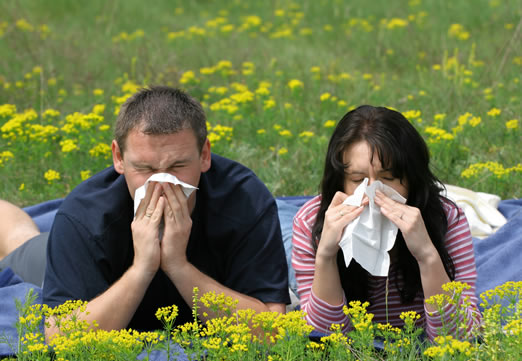Prof. Suveer Singh
BSc MBBS PhD EDIC DICM FHEA FFICM FRCP
Consultant in Respiratory Medicine
Specialist in Respiratory, Sleep and Critical Care
Professor of Practice at Imperial College
4th Floor 369 Fulham Road London SW10 9NH
Allergies

The problem with allergies such as Hay fever and Allergic Rhinitis is that it is considered to be a trivial and inconsequential disease. Symptoms such as runny nose, itchy eyes and nose with sneezing and blockage are obviously not life threatening, but affect up to 25% of the population and are the cause of significant disability and cost to society. Patients may also experience fatigue, irritability, as well as mood, cognitive and sleep disturbance in addition to the nasal, ocular and throat symptoms. Allergic rhinitis has important co-morbid associations such as chronic sinusitis, glue ear, asthma exacerbations, nasal polyps, sleep apnoea and dental malocclusion.
Chronic Allergic Rhinitis sufferers often have typical facial features called the "allergy face". Nasal blockage and sinus congestion predispose to the bluish discolouration of the lower eyelids called "allergic shiners", the characteristic linear creases under the eyelid are referred to as "Dennes lines". Constant nasal rubbing typifies the "allergic salute" and results in a prominent "nasal crease" across the nose. Continuous nasal blockage causes "nasal" speech and mouth breathing with disturbed sleep. This results in a high arched palate and the "long face syndrome" with dental crowding and malocclusion ("Buck teeth").
Allergic rhinitis may be either seasonal or perennial:
Seasonal allergic rhinitis is better known as "Hay fever".
Tree and grass pollens and some fungi trigger seasonal allergic rhino-conjunctivitis (nose and eye allergy) during Springtime and early Summer (March to June). Allergy sufferers experience intense nasal and eye itching with explosive sneezing, watery eyes and nose and itchy palate and ears with profuse post-nasal drip. These people do not develop the typical "allergy face" but have seasonal puffiness of the eyes and eyelids with associated nasal membrane swelling.
Perennial allergic rhinitis or a "permanent cold".
Allergens such as house-dust mite droppings, cat and dog dandruff, horse hair, cockroach droppings and perhaps hamster or rabbit urine result in perennial allergic rhinitis with symptoms all year round. These patients are often misdiagnosed as having a "permanent" cold and receive inappropriate treatment with antibiotics. Their symptoms can be very subtle and include constant nasal blockage, snoring at night, watery post-nasal discharge, loss of taste and smell sensation and sneezing only on waking in the morning. Coexistent glue ear and chronic sinusitis with polyps (grape-like swellings inside the nose) are common.
In 1999, the World Health Organisation introduced a new classification for Allergic Rhinitis (ARIA Guidelines). The purpose was to try and create similar treatment guidelines for asthma and allergic rhinitis which often co-exist in the same patient (80% of asthma sufferers have concomitant allergic rhinitis). Instead of the traditional seasonal and perennial divisions, they introduced Intermittent Allergic Rhinitis and Persistent Allergic Rhinitis. Intermittent would replace the Seasonal (Hay fever) type disease and Persistent would replace Perennial Rhinitis (but some overlap does take place). These two groups are then further sub-divided into Mild and Moderate/Severe symptoms and treated according to the new guidelines.
Allergic inflammation.
Allergic rhinitis occurs in "atopic" youngsters usually with raised blood levels of IgE antibodies to the common inhalant allergens such as house dust mites, tree and grass pollen, animal dander, cockroaches and mould spores. Occasionally foods such as milk and food additives can cause worsening symptoms. Children are sensitised in early life but may only manifest their allergy symptoms later in life. Perennial allergic rhinitis usually manifests before the age of 10 years, while seasonal allergic rhinitis occurs more commonly in teenagers and young adult males. Primary sensitisation results in the production of specific IgE antibodies, which later cross-link with allergens on mast cells in the nasal membranes releasing histamine and the allergy cascade. If the condition becomes more entrenched as occurs in chronic perennial rhinitis, then other inflammatory mediators and immune cells become involved.
The allergy reaction in the nose involves a complex interaction between various inhalant allergens and immune cells. An allergen will link to specific IgE antibodies on mast cells near the nasal surface, resulting in histamine release. This is termed the Immediate Allergic Reaction. Other chemicals released by Mast cells include tryptase and prostaglandin. Histamine has a direct effect on nasal blood vessels causing swelling and nasal obstruction. It also has a reflex effect via sensory nerves causing sneezing, itching and further mucus production. This triggers a sequence of events with sneezing followed by watery nasal discharge and finally nasal blockage.
Subsequent nasal symptoms that develop between 3 and 12 hours after the initial allergen exposure are due to the Late Phase Reaction. Further immune mediator production occurs in the already inflamed nasal membranes and blood cells (eosinophils and basophils) infiltrate causing progressive nasal blockage and swelling.
Nasal hypersensitivity occurs when non-allergenic irritants such as dusts, perfume, tobacco smoke, ozone, sulphur dioxide, nitrogen dioxide, cold air and other environmental pollutants result in increased nasal membrane leakiness, increased nerve excitability, white blood cell infiltrates and more mast cells in the superficial nasal membranes. These factors lead to an increased nasal irritability to low doses of allergens. Some older blood pressure medications such as reserpine, methyldopa, ACE inhibitors and alpha blockers as well as hormone replacement therapy (HRT) may in addition cause nasal obstruction. The last trimester of pregnancy is associated with worsening of nasal symptoms due to hormonal factors. While aspirin sensitive individuals will often develop rhinitis, sinusitis and nasal polyps after aspirin re-exposure.
For Enquiries
Email us your queries at












